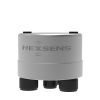YOUNG Ultrasonic 3D Anemometers
Features
- 3D wind sensor with no moving parts
- Provides a complete picture of the wind
- Constructed with three opposing pairs of ultrasonic transducers
- Free ground shipping
- Expedited repair and warranty service
- Lifetime technical support
- More
Overview
The RM Young 81000 Ultrasonic 3D Anemometer is a 3D wind sensor with no moving parts. While other 2-D anemometers ignore the vertical wind component, the 81000 provides a complete picture of the wind. Constructed with three opposing pairs of ultrasonic transducers, it provides accurate and reliable wind measurements.
Durable
The sensor features robust construction with 3 opposing pairs of ultrasonic transducers supported by stainless steel members. This arrangement provides rigidity to the anemometer while offering a measure of protection to the transducers. The transducers are arranged so that measurements are made through a common volume, thereby improving the validity of the measurement. A fast, 160 Hz sampling rate ensures superior measurement resolution.
Customizable
The RM Young 81000 Ultrasonic 3D Anemometer features (4) voltage output channels. Serial RS-232 and RS-485 outputs are available as well. For applications requiring synchronized analog measurements, Model 81000V includes four voltage input channels instead of voltage outputs. Wind, sonic temperature, and voltage input data are transmitted serially. A variety of preset or custom output format options may be selected by the user. The 81000 installs on standard 1" (IPS) pipe. Wiring connections are housed in a convenient weatherproof junction box.
In The News
Flux towers track CO2 exchange between forests and atmosphere
Determining exchange rates of carbon dioxide between the earth’s forests and the atmosphere is turbulent business. Wind above forest canopies swirls as vortexes of air enter and exit stands of trees. Across the globe, towers stand among the landscape, with sensors monitoring these eddies for carbon dioxide, water vapor and other gasses. These so-called “flux towers” collect data on carbon dioxide exchange rates between the earth and atmosphere. Information gathered plays into the debate on the measurable effects of climate change. Carbon dioxide flows between the earth, atmosphere and ocean in an attempt to reach equilibrium. As automobiles and energy production facilities burn fossil fuels, more carbon dioxide joins to the mix.
Read MoreVillage Green Project builds air quality awareness with monitoring park bench
The U.S. Environmental Protection Agency is on a mission to make air quality monitoring cheaper, easier and more accessible through the implementation of innovative new monitoring stations. The Village Green Project is a new initiative from the EPA that seeks to increase the scope of air quality monitoring by seamlessly incorporating monitoring devices into community settings. Led by Gayle Hagler, an environmental engineer at the EPA Office of Research and Development, an EPA design team has constructed a prototype that combines the ability to monitor ozone and fine particulate matter as well as wind speed, wind direction, temperature and humidity all into the functional design of a park bench.
Read MoreRM Young 81000 Ultrasonic Anemometer: Fast response, high resolution for 3D wind data
The RM Young 81000 Ultrasonic Anemometer is a high-quality 3-axis wind sensor with no moving parts. It is perfectly suited for applications requiring fast response, high resolution and three dimensional wind measurements. With no moving parts, the sensor is less susceptible to damage from field deployment and is a good choice over the long term. The “81000 uses ultrasonic sound waves to measure wind velocity,” said Andy Oliver, product manager at the RM Young Company. The sensor measures wind speed based on the time of flight of sonic pulses between pairs of transducers. The 81000 also measures the speed of sound, an intriguing parameter of its own. “The speed of sound varies depending on the temperature of the air through which the sound moves,” said Oliver.
Read More












